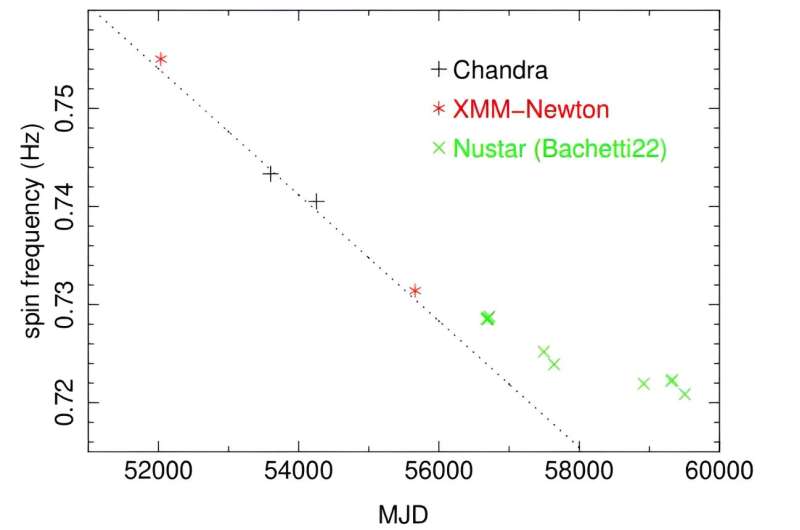January 4, 2024 report
This article has been reviewed according to Science X's editorial process and policies. Editors have highlighted the following attributes while ensuring the content's credibility:
fact-checked
preprint
trusted source
proofread
Researchers investigate pulsations of the ultra-luminous X-ray pulsar M82 X-2

Using NASA's Chandra spacecraft and ESA's XMM-Newton satellite, Chinese astronomers have inspected the pulsations of an ultra-luminous X-ray pulsar known as M82 X-2. Results of the study indicate that the pulsar showcases a long-term spin-down trend. The study was detailed in a paper published December 28 on the pre-print server arXiv.
Ultra-luminous X-ray sources (ULXs) are point sources in the sky that are so bright in X-rays that each emits more radiation than 1 million suns emit at all wavelengths. Although they are less luminous than active galactic nuclei, they are more consistently luminous than any known stellar process.
Astronomers generally believe that due to their brightness, most ULXs are black holes. However, recent observations have found that some ULXs showcase coherent pulsations. These sources, known as ultra-luminous X-ray pulsars (ULXPs), are neutron stars typically less massive than black holes. The list of known ULPs is still relatively short; thus, studying objects of this class is essential for researchers exploring the universe in X-rays.
M82 X-2 is the first discovered ULXP. It is located in the Cigar Galaxy (also known as Messier 82), at a distance of about 12 million light years away. The system consists of a neutron star, with a spin period of approximately 1.37 seconds, and a much more massive companion.
Given that many properties of M82 X-2 still remain unclear, a team of astronomers led by Jiren Liu has analyzed archival Chandra and XMM-Newton data in order to better understand its nature, especially its pulsation.
Liu's team managed to measure the pulsation behavior of M82 X-2 back to 2001. They determined spin frequencies of this ULXP, which allowed them to identify a clear spin-down trend over a timescale of 20 years, with occasional spin-up events. Such spin behavior is usually observed in Be-type X-ray binaries (BeXBs).
"BeXBs generally show a spin-up trend during an outburst or giant outburst state, and show a continuous spin-down trend when there is much less mass to be accreted," the researchers explained.
According to the study, the changing spin-down/spin-up behavior of M82 X-2 seems to suggest that its accretion torque, and therefore its accretion rate, must be varying. Based on these findings, the astronomers suppose that M82 X-2 may have a varying accretion rate, and for long periods of time it is in a relatively quiet state and spins down.
In trying to explain the cause of the observed spin-down trend observed in M82 X-2, the authors of the paper consider a few possibilities. They assume that the most plausible hypothesis is that such a trend is due to magnetic threading. If this scenario is true, they estimate that the dipolar magnetic field of this pulsar is at a level of 12 trillion Gauss.
More information: Jiren Liu, The long-term spin-down trend of ultra-luminous X-ray pulsar M82 X-2, arXiv (2023). DOI: 10.48550/arXiv.2312.16770
Journal information: arXiv
© 2024 Science X Network





















